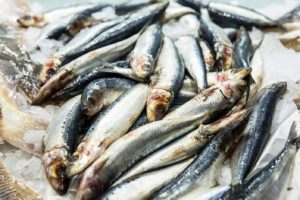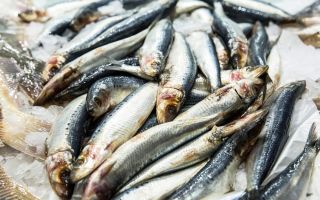Content
- 1 What does sardine look like and where is it found
- 2 Chemical composition of sardines
- 3 Nutritional value and calorie content of sardines
- 4 Useful properties of sardines
- 5 The benefits and harms of canned sardines
- 6 How to cook sardines
- 7 Canned Sardine Recipes
- 8 Harm of sardines and contraindications
- 9 How to choose and store sardines
- 10 Conclusion
Sardine is a small size marine fish belonging to the herring family. They inhabit and migrate in large flocks, forming chains 7-12 km long. Consider the health benefits and harms of sardines, the beneficial properties and delicious ways of cooking fish.

What does sardine look like and where is it found
Sardine is classified as a commercial fish species. She was first caught in the waters of the Mediterranean. The sardine got its name from the Italian island of Sardinia, where they first started fishing on it. The fish is usually about 15-20 cm, but there are individuals reaching a length of 25 cm. Compared to herring, this type of fish is larger and has a thicker body.
Sardine has silvery shiny scales, in the photo of the fish you can see yellow-green shades of scales with tints of gold. The sardine has a large head, mouth, an elongated body, a tail-type fin with several wing scales at the end. This special structure allows the sardines to float very quickly. In some subspecies of fish, dark stripes diverge from the gills.
Sardine is widespread almost all over the world and is found in most seas: the Black, Mediterranean, Adriatic seas, off the eastern shores of China, Korea, and Japan. It is often found off the Australian coast of the Pacific Ocean, off the coast of Peru, India, and South Africa.

Chemical composition of sardines
Sardine is one of the richest sources of various nutrients. It contains vitamins D, B4, B5, B6, B12, PP, minerals - selenium, zinc, iron, chromium, cobalt, essential macronutrients - sodium, saturated fats. For 100 g of fish there are 27 g of proteins, 11 g of fat and 0 g of carbohydrates. Thanks to this, sardine fish brings great benefits to the body, therefore it is popular among athletes, it is considered a dietary product.
Nutritional value and calorie content of sardines
The calorie content of 100 g of raw fish is 168 kcal. However, this value varies depending on how the sardine is prepared.
|
Cooking method |
Calorie content |
|
Raw |
168 |
|
Canned in oil |
221 |
|
Boiled |
150 |
|
In tomato paste |
189 |
Useful properties of sardines
Sardines are rich in healthy saturated fats - Omega-3, Omega-6, the balance of which helps prevent the development of many diseases, help in the treatment of a number of serious problems. Fish is a source of many types of amino acids that benefit the body.
For heart
Sardine also helps in the prevention of diseases of the cardiovascular system - hypertension, arthrosclerosis. It prevents the risk of heart attack, stroke due to essential fatty acids, B vitamins, which prevent the formation of blood clots inside the vessels, are actively involved in the processing of glucose into energy.
For bones
Calcium, manganese, phosphorus - the main elements that help form in a young and strengthen bones in older age - are found in large quantities in sardines. Vitamin D plays an important role in healthy bone development. The skeleton of fish is soft, so it is often eaten without harm with bones, while receiving the additional benefit of a dose of calcium.

For cancer prevention
The most common cancers at the moment are leukemia, multiple myeloma, prostate or breast cancer. Doctors, scientists advise to eat more fish saturated with healthy fats, including sardine, which contains selenium and vitamin D, to prevent the development of these ailments.
For immunity
Sardine is especially beneficial in the autumn and spring, when there is a high probability of contracting infectious diseases, so it must be included in the diet. Fish oil, a high concentration of vitamins D, C at a high level tend to protect the body, increasing its immunity, resistance to various diseases.
For the nervous system and mood
Omega-3 fatty acid obtained from animal products, mainly fish, is best absorbed in the body. This essential ingredient plays an important role in reducing stress levels and improving the functioning of the nervous system. Studies have shown that people who consume insufficient amounts of fat are more susceptible to nervous diseases, mental disorders - depression, nervous breakdowns, constant stress. Sardine, rich in Omega-3, helps regulate brain function, significantly improves emotional well-being, and reduces harm from environmental anxiety factors.
For sight
Regular consumption of seafood - fish, seaweed, sea crustaceans - helps prevent the risk of age-related vision impairment. Beneficial fatty acids, combined with a variety of nutrients, give sardine the healing properties of macular degeneration and dry eye.
With diabetes
Healthy animal protein increases the body's resistance to insulin surges. This fish can be paired with wheat pasta, white bread, and some simple carbohydrates without fear of spikes and drops in blood sugar.
Slimming
Sardines are rich in healthy fats, animal proteins that fill you up quickly and keep you from feeling hungry for a long time. This fish is low in calories, but contains a large amount of essential vitamins, minerals that are beneficial. It occupies an important place in the diet of athletes who need to consume a fairly low-calorie protein food. However, the fish will also not harm people who want to lose those extra pounds and get into the desired shape.
For skin and hair
Fatty Omega-3 acids, selenium, zinc improve the condition of hair, skin, nails. They saturate, nourish cells, promote the activation of hair follicles, help reduce the influence of age factors on the general condition of the skin.

The benefits and harms of canned sardines
Here canned fish can come to the rescue, but it is important to correctly and wisely approach their choice, having first figured out what benefits and harms canned sardines bring to the body. It is produced in three types: in oil, tomato sauce, and its own juice.
5 important properties of canned fish:
- Preservation of fish allows you to preserve its beneficial qualities for a longer period through the use of special ingredients, while preserving all the nutrients.
- Canned fish contains a large amount of iodine, which takes an active part in the synthesis of enzymes that tend to accelerate digestion.
- The most useful is sardine in its own juice. With this method of conservation, all vitamins and minerals of fish enhance their properties due to active interaction with each other.
- The harm of canned fish is the high content of salts, which, if consumed excessively, can cause swelling. Therefore, it is not recommended to eat canned food in moderation in the early morning and late at night.
- It is important to carefully check the composition, read all the information on the packaging of the fish, as some manufacturers use unnatural preservatives in their production, which can lead to poisoning and the development of diseases.
How to cook sardines
The fish is most widespread in the Mediterranean countries - Italy, France, Greece, Spain. Residents are sure that sardine is beneficial for the body, and harm is only possible if you cook dishes from stale fish. There are many ways of cooking, and everyone can choose something interesting and useful for themselves.
Canned Sardine Recipes
A wide variety of real delicacies can be prepared from canned sardines: it will be an original ingredient in light soups and snacks, salads, casseroles, rolls and pies. Canned food itself serves as a semi-finished product, which significantly reduces the cooking time. This means that such quick recipes will come in handy in the arsenal of every housewife.
Below are the most popular sardine recipes:
Classic mimosa salad with sardines
This dish is widely known and requires little effort to prepare. In order to achieve a juicy taste and the desired consistency, it is important to choose the right ingredients, follow a clear cooking plan. What do you need?
- sardine - 1 can;
- boiled eggs - 5 pcs.;
- onions - 0.5 pcs.;
- hard cheese (Dutch, maasdam, parmesan) - 160 g;
- dressing - optional (mayonnaise, sauce, sour cream).
The main feature of the salad is that it is prepared in layers.
Video recipe for making Mimosa salad:
- Put boiled and chopped egg whites in the first layer. Separate the yolks and leave for later.
- The second layer is put cheese, grated on a fine grater.
- Next, cover everything with any sauce to taste.
- After that, you need to open a jar of canned fish, drain the water from there and put it in a third layer.
- Finely chopped onions are placed on top of the fish to add a special taste.
- Cover everything with sauce, sprinkle with grated yolk and cheese on top.

Canned sardine soup
For this healthy recipe, you will need the following products:
- sardine - 1 can;
- water - 2 l;
- potatoes - 2 pcs.;
- carrots - 1 pc.;
- onions - 1 pc .;
- greens - parsley, dill, cilantro;
- spices: black pepper, bay leaf, caraway seeds, salt - to taste.
Cooking procedure:
- First you need to prepare the vegetables - dice the potatoes, carrots and onions.
- Add them one by one to boiling salted water. The first is potatoes, after 5-7 minutes - carrots and onions.
- Pepper everything, put bay leaf and other spices as desired.
- When the potatoes are completely softened, put a can of sardines in a saucepan.
- After that, cook the soup until fully cooked for 8-10 minutes.
Serve garnished with herbs.
Harm of sardines and contraindications
In certain situations, sardines can be harmful to humans. Fish contains special substances - purines, which contribute to the development of gout, the formation of uric acid, which leads to the deposition of kidney stones.
Some rare amino acids - tyramine, phenylethylamine, histamine - can cause allergic reactions in some people.
How to choose and store sardines
When buying canned fish, it is important to consider a number of factors that affect its quality:
- First of all, sardine in oil should not have a pungent odor, be a soft silvery color, have an elastic flexible shape and not decay - this is the only way it will give the maximum benefit and will not bring harm.
- Secondly, the jar should not have any defects, be free of small holes and dents.
- Thirdly, it is important that the expiration date and composition are clearly stated. For quality fish, the shelf life is within 2 years at a temperature of + 13 °. After opening, it can be left in the refrigerator for up to two days.
Conclusion
It is important to carefully study all the factors in which the benefits and harms of sardines take place. This fish is an easy dietary product, a rich source of all kinds of protein and nutrients, but it is important to observe measure and caution, especially for people prone to allergic reactions to foods.

